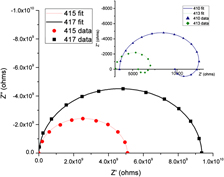Article contents
The effect of substrate pore size on the network interconnectivity and electrical properties of dropcasted multiwalled carbon nanotube thin films
Published online by Cambridge University Press: 07 June 2013
Abstract

Four-layer multiwalled carbon nanotube (MWNT) thin films were deposited via dropcasting (1 mg/mL MWNTs and 10 mg/mL SDBS) onto filter papers that vary in pore size (1, 5, 25, and 40 µm) to determine the effect of the underlying substrate structure on the in-plane properties of the films. The films (<100 nm thick) were dried using vacuum filtration, and drying in a 65 °C heater with and without a ceramic heating board. DC resistance of the films ranged from 6 × 103 to 9.3 × 109 Ω. Impedance spectroscopy analysis revealed a low and a high frequency inductive response and two parallel R–C circuits for the more conducting thin films. High resistance films were fit by a single RC circuit with a constant-phase element. The differences in the in-plane electrical responses of the different MWNT films can be explained by the degree of carbon nanotube surface coverage, obtained as a result of using different pore size filter papers. The drying method utilized also affected the CNT network formation and its resultant electrical properties.
- Type
- Articles
- Information
- Copyright
- Copyright © Materials Research Society 2013
References
REFERENCES
- 11
- Cited by




